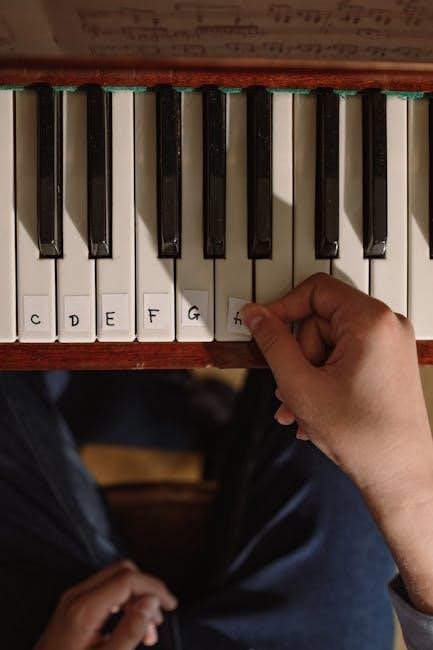Minor scales are fundamental for pianists, offering a rich, emotive sound. They come in three forms: natural, harmonic, and melodic, each with unique intervals and uses. PDF resources provide comprehensive guides, including fingerings and notation, making them essential for practice and mastery.
Overview of Minor Scales
Minor scales are essential for pianists, offering a foundation for melody and harmony. They exist in three primary forms: natural, harmonic, and melodic, each with distinct interval structures. The natural minor scale, also known as the Aeolian mode, is the most basic form, while the harmonic and melodic scales introduce raised leading tones for musical tension. These scales are closely related to major scales, with the natural minor being the relative minor of a major key. PDF resources provide detailed notes, fingerings, and diagrams, making them invaluable for practice. Understanding minor scales enhances composition, improvisation, and performance, allowing pianists to explore a wide range of emotional expressions in music.
Importance of Minor Scales in Piano Learning
Mastering minor scales is crucial for pianists, as they form the basis of musical expression and technique. Minor scales enhance finger dexterity, improve hand positioning, and strengthen musical understanding. They are fundamental for composing and improvising, allowing pianists to create emotionally rich melodies. Additionally, minor scales are essential for harmonizing chords and understanding key relationships. PDF guides offer structured practice materials, including fingerings and notation, which aid in consistent progress. By learning minor scales, pianists gain the tools to explore various musical styles, from classical to contemporary, and develop a deeper appreciation for music theory and performance.
Types of Minor Scales
There are three primary types of minor scales: natural, harmonic, and melodic. The natural minor scale, also known as the Aeolian mode, features a distinct sequence of whole and half steps. The harmonic minor scale raises the seventh note by a half step, creating a leading tone. The melodic minor scale has two forms: ascending, with a raised sixth and seventh note, and descending, which mirrors the natural minor; Each type offers unique harmonic and melodic possibilities, making them essential for pianists to master. PDF resources provide detailed charts and fingerings for all three forms, aiding in comprehensive practice and understanding.

Natural Minor Scales
Natural minor scales, also known as Aeolian mode, follow a specific whole-half step pattern. They are often associated with a melancholic sound and are closely related to major scales through relative keys. PDF resources provide detailed charts and fingerings for all 12 natural minor scales, aiding pianists in mastering their structure and emotional depth.
Structure of the Natural Minor Scale
The natural minor scale, also known as the Aeolian mode, follows a specific sequence of whole and half steps: W-H-W-W-H-W-W. This pattern creates a distinct, melancholic sound. Each scale consists of seven notes, with the tonic note serving as the starting point. For example, the A natural minor scale includes the notes A, B, C, D, E, F, and G. This structure is consistent across all 12 natural minor scales, making it a foundational element for pianists to learn. PDF resources often include diagrams and fingerings to help musicians master this essential scale structure.
Intervals in the Natural Minor Scale
The natural minor scale is defined by its interval pattern: whole, half, whole, whole, half, whole, whole. This sequence creates the distinctive sound of the minor scale. Starting from the tonic, the intervals are: 1, 2, b3, 4, 5, b6, b7. For example, in the A natural minor scale, the intervals are A-B (whole), B-C (half), C-D (whole), D-E (whole), E-F (half), F-G (whole), and G-A (whole). These intervals give the natural minor scale its melancholic quality. PDF resources often highlight these intervals, providing clear visual guides for pianists to understand and practice the scale effectively.
Relative Major and Minor Keys
Relative major and minor keys share the same set of notes but differ in their tonal center. For instance, C major and A minor are relative keys, as they both consist of the same notes. The relative minor of a major key is found by lowering the third scale degree by a half step. Conversely, the relative major of a minor key is found by raising the third scale degree by a half step. This relationship allows for easy transposition and modulation between keys. PDF guides often include charts and exercises to help pianists identify and practice these relative keys, enhancing their understanding of key signatures and harmonic relationships.
Fingerings for Natural Minor Scales
Fingerings for natural minor scales are standardized to ensure smooth, efficient playing. For example, in A minor, the left-hand fingering is 5, 4, 3, 2, 1, 3, 2, 1, while the right-hand fingering is 1, 2, 3, 1, 2, 3, 4, 5. These patterns are consistent across all keys, with slight variations to accommodate different hand shapes and note ranges. PDF guides often include detailed fingerings for both hands, making it easier for pianists to practice and master each scale. Consistent use of proper fingerings helps build technique and ensures accurate, expressive performance. Practicing scales with correct fingerings is essential for developing muscle memory and fluency in natural minor scales.
Harmonic Minor Scales
Harmonic minor scales are a variation of natural minors, featuring a raised seventh degree. This alteration creates a leading tone, enhancing harmonic tension and emotional depth in music. PDF guides provide clear notation and fingerings for all harmonic minor scales, aiding pianists in mastering their unique structure and application. These scales are particularly useful in composition and improvisation, offering rich harmonic possibilities. Regular practice with provided resources ensures proficiency and expressive performance of harmonic minor scales.
Differences from Natural Minor Scales
The harmonic minor scale differs from the natural minor by raising the seventh scale degree by a semitone. This alteration creates a leading tone, which strengthens harmonic function and adds emotional intensity. Unlike the natural minor, the harmonic minor scale is not relative to a major scale but maintains its own distinct character. This raised seventh degree also affects the intervals within the scale, particularly the major seventh interval between the sixth and seventh degrees. PDF resources highlight these differences, providing clear comparisons and fingerings for both scales. Understanding this distinction is crucial for pianists aiming to master harmonic minor scales and their unique applications in music composition and improvisation.
Construction of the Harmonic Minor Scale
The harmonic minor scale is constructed by raising the seventh degree of the natural minor scale by one semitone. This alteration creates a leading tone, which gives the scale a distinct harmonic function. The intervals in the harmonic minor scale follow the pattern of whole and half steps: W-H-W-W-H-W-W. For example, in the A harmonic minor scale, the notes are A, B, C, D, E, F, G#, A. This raised seventh degree (G# in A harmonic minor) differentiates it from the natural minor scale and adds a bright, tense quality. PDF resources often include fingerings and notation for harmonic minor scales, making them easier to learn and practice.

Common Uses of the Harmonic Minor Scale
The harmonic minor scale is frequently used in various musical contexts to create tension and emotional depth. It is commonly employed in classical music for modulation and dramatic effects. Jazz and improvisational musicians also utilize the harmonic minor scale to add exotic flavors and complex harmonies. Additionally, it is often featured in film scores and world music to evoke specific cultural or emotional atmospheres. The raised seventh degree in the harmonic minor scale makes it particularly effective for creating melodic interest and harmonic richness. PDF guides and resources often highlight these applications, providing practical examples and exercises to help pianists master the scale and explore its versatile uses in composition and performance.

Fingerings for Harmonic Minor Scales
Fingerings for harmonic minor scales are designed to facilitate smooth navigation of the scale’s unique structure. PDF resources often provide detailed fingerings, with left-hand (LH) and right-hand (RH) fingerings clearly marked above each note. These fingerings are optimized for hand positioning and dexterity, ensuring even tone production and technical accuracy. For example, the harmonic minor scale in C features specific finger assignments to accommodate the raised seventh degree. Consistent practice with these fingerings helps pianists master the scale’s challenging intervals and transitions. Many PDF guides include fingerings for all 12 harmonic minor scales, offering a comprehensive approach to learning and memorization. This structured approach is essential for building technical proficiency and expressive control.

Melodic Minor Scales
Melodic minor scales are versatile, used in both ascending and descending forms. They feature distinct intervals, enhancing musical expression. PDF guides provide clear notation and fingerings for practice, aiding pianists in mastering these scales effectively.
Ascending and Descending Forms
The melodic minor scale has distinct ascending and descending forms. When ascending, it features a raised 6th and 7th scale degree, creating a bright, expansive sound. In descent, it reverts to the natural minor form, with the 6th and 7th degrees lowered, producing a somber, reflective quality. This dual nature makes the melodic minor scale highly expressive and versatile for composition and improvisation. PDF resources often include both forms, providing pianists with clear fingerings and notation to master these transitions smoothly. Practicing both directions is essential for understanding the scale’s emotional depth and technical demands.
Intervals in the Melodic Minor Scale

The melodic minor scale features distinct intervals in its ascending and descending forms. Ascending, the intervals are whole, half, whole, whole, whole, whole, and half steps, creating a bright, tense sound due to the raised 6th and 7th degrees. Descending, it follows the natural minor pattern: whole, half, whole, whole, half, whole, and whole steps, resolving the tension and producing a somber quality. This duality allows for rich emotional expression. PDF guides often detail these intervals, aiding pianists in mastering the scale’s unique structure and enhancing their musicality through practice.
Practical Applications of the Melodic Minor Scale
The melodic minor scale is versatile, commonly used in composition and improvisation. Its ascending form, with raised 6th and 7th degrees, adds tension, making it ideal for creating dramatic or exotic melodies. In jazz, it’s often employed for solos and chord progressions, particularly over dominant chords. Classical composers use it to evoke emotional depth. PDF resources provide exercises and etudes that help pianists apply the scale in various musical contexts, enhancing their technical and expressive skills. Regular practice with these materials allows pianists to integrate the melodic minor scale effectively into their performances, expanding their musical versatility and artistry.
Fingerings for Melodic Minor Scales
Fingerings for melodic minor scales are designed to facilitate smooth navigation of the keyboard while maintaining proper hand position. For the right hand, fingerings typically follow a pattern of 1-2-3-1-2-3-4-5, adjusting slightly for the raised 6th and 7th degrees in the ascending form. The left hand often uses a 5-4-3-2-1-3-2-1 pattern, ensuring evenness and control. PDF resources provide detailed fingerings for all melodic minor scales, with numbers placed above or below the notes for clarity. Practicing these fingerings consistently helps build technical proficiency and mastery of the scale. These guides are invaluable for pianists aiming to perform melodic minor scales with precision and musicality.
Minor Scales in Different Keys

Understanding minor scales across all keys enhances musical versatility. Each key has a unique character, with specific intervals and fingerings. PDF guides provide comprehensive charts for every minor key, aiding pianists in mastering their distinct sounds and applications.
Understanding the Circle of Fifths for Minor Keys
The Circle of Fifths is a powerful tool for understanding minor keys. It organizes keys in a sequence where each key is a perfect fifth apart. For minor keys, the circle starts at C minor and moves clockwise, adding sharps or flats as you progress. Each minor key has a relative major key, sharing the same key signature. For example, A minor is the relative minor of C major. This relationship simplifies learning, as the notes remain the same but the tonic changes. PDF guides often include the Circle of Fifths, helping pianists visualize and memorize minor key relationships efficiently.
Chromatic Order of Minor Scales

The chromatic order of minor scales arranges all 12 minor keys in sequence, each starting on a different note. This sequence includes C, C#/Db, D, D#/Eb, E, F, F#/Gb, G, G#/Ab, A, A#/Bb, and B. Each minor scale follows the natural minor formula: whole, half, whole, whole, half, whole, whole steps. PDF resources often list these scales in chromatic order, making it easier to compare and learn them. Understanding this order helps pianists recognize patterns and relationships between keys. It also aids in mastering key signatures and intervals, essential for both natural, harmonic, and melodic minor scales. This systematic approach simplifies practice and enhances musical understanding.
Key Signatures for Minor Scales
Key signatures for minor scales indicate the specific sharps or flats in each key. Natural minor scales share their key signatures with their relative major keys. For example, A minor shares the same key signature as C major, with no sharps or flats. The number of sharps or flats increases as you move through the circle of fifths. PDF resources often include charts that list all 12 natural minor scales with their corresponding key signatures, making it easier to identify and memorize them. Understanding key signatures is crucial for sight-reading and composing in minor keys. They provide a visual guide to the tonality and structure of each scale, aiding pianists in mastering minor scales effectively.

Resources for Learning Minor Scales
Downloadable PDFs provide comprehensive guides, including fingerings and notation. Interactive tools and backing tracks enhance practice. These resources support effective learning and mastery of minor scales for pianists.
PDF Downloads for Minor Scales
PDF downloads offer a convenient way to access minor scales, including natural, harmonic, and melodic forms. These files typically include notes, fingerings, and diagrams for both hands. Many resources provide scales in all keys, making them versatile for practice. Teachers often use these PDFs as handouts for students, ensuring consistent learning materials. Additionally, some websites offer comprehensive guides that combine scales with related chords and arpeggios. These downloads are ideal for musicians seeking structured practice materials, allowing them to focus on technique and musicality. They are widely available, often for free, and cater to both beginners and advanced pianists.
Interactive Tools for Practicing Minor Scales
Interactive tools are an excellent way to engage with minor scales, offering dynamic and immersive practice experiences. These tools often include features like scale generators, virtual keyboards, and adjustable tempos. Many platforms allow users to select specific scales, such as natural, harmonic, or melodic minors, and practice them in any key. Some tools also provide metronomes, enabling precise timing and rhythm development. Additionally, interactive software can offer real-time feedback, helping pianists improve accuracy and technique. These resources are particularly useful for both beginners and advanced players, as they cater to diverse skill levels and learning styles. They complement traditional methods, making scale practice more engaging and effective.
Backing Tracks for Minor Scale Practice
Backing tracks are invaluable for enhancing minor scale practice, providing rhythmic accompaniment and a professional feel. These tracks, often available in various tempos and time signatures, allow pianists to apply scales in musical contexts. They help develop timing, phrasing, and expression, making practice more engaging. Many websites offer tracks specifically designed for minor scales, catering to different skill levels. Beginners can start with slower tempos, while advanced players can challenge themselves with faster speeds. Additionally, tracks may include chord progressions, enabling integration of scales into improvisation or composition. Regular use of backing tracks can significantly improve a pianist’s ability to perform scales fluidly and musically, enhancing overall technique and artistry.

Practicing Minor Scales
Consistent practice is key to mastering minor scales. Start with a metronome at 60bpm, focusing on quality over speed. Use PDF guides for fingerings and notes to enhance accuracy and fluency.
Beginner Tips for Mastering Minor Scales
Beginners should start by practicing one octave of each minor scale slowly, using a metronome at 60bpm. Focus on proper finger placement and hand position to avoid injury. Break scales into smaller sections and gradually increase speed. Utilize PDF guides for accurate fingerings and note sequences. Prioritize natural minor scales first, as they share notes with relative major scales. Regular practice, even for short durations, builds consistency. Listening to recordings helps internalize the sound. Incorporate scales into daily routines for steady progress.
Advanced Techniques for Minor Scale Mastery
Advanced pianists can enhance their minor scale proficiency by exploring harmonic and melodic variations. Practice scales in thirds, sixths, and arpeggios to improve dexterity. Focus on nuanced dynamics and articulation for expressive playing. Incorporate improvisation using minor scales over chord progressions to develop musicality. Experiment with modal interchange, blending minor scales with related modes. Use advanced fingerings and rhythmic variations to add complexity. Regularly practice in all keys to build versatility. Utilize PDF resources for detailed fingerings and harmonic analysis. Record and analyze performances to refine technique. Consistent practice and creative application will elevate minor scale mastery to an artistic level.
Common Challenges and Solutions
One common challenge when learning minor scales is maintaining proper hand position and finger dexterity. To address this, practice scales slowly with a metronome, focusing on even tone and smooth transitions. Another issue is memorizing all 12 keys, which can be overwhelming. Break them into groups and use the circle of fifths to identify relative majors. Difficulty in distinguishing between natural, harmonic, and melodic forms can arise; compare their intervals and practice each type separately. Additionally, intonation errors can occur, especially in harmonic and melodic scales. Use PDF charts with fingerings and intervals to guide practice. Regular review and consistent practice will help overcome these challenges and improve overall proficiency.
Applications of Minor Scales in Music
Minor scales add emotional depth and versatility to compositions, improvisations, and popular music. They are widely used to evoke mood, create complexity, and enhance musical expression across various genres.
Using Minor Scales in Composition
Minor scales are a powerful tool in composition, offering a wide range of emotional expression. Composers often use natural, harmonic, and melodic minor scales to create somber, reflective, or dramatic moods. The natural minor scale, with its distinct intervals, is particularly suited for melancholic themes, while the harmonic minor scale introduces tension through its raised seventh degree, making it ideal for dramatic climaxes. The melodic minor scale, with its ascending and descending forms, adds complexity and versatility. By incorporating these scales, composers can craft pieces that resonate deeply with listeners, leveraging the unique characteristics of each minor form to convey intricate emotions and narratives.
Improvisation with Minor Scales
Minor scales are a cornerstone of improvisation, offering a rich palette of emotions and tonal colors. Pianists can use natural, harmonic, and melodic minor scales to create expressive solos, with each scale providing unique harmonic possibilities. The natural minor scale, with its somber tone, is ideal for introspective improvisations, while the harmonic minor scale adds tension and drama through its raised seventh degree. The melodic minor scale, with its ascending and descending forms, offers versatility and complexity. By mastering these scales, pianists can craft compelling improvisations, leveraging their distinct intervals and emotional depth. PDF resources, such as scale charts and fingering guides, are invaluable tools for refining improvisational skills and exploring the vast potential of minor scales in real-time performance.
Minor Scales in Popular Music
Minor scales are prevalent in popular music, evoking emotions ranging from melancholy to excitement. Many hit songs utilize natural, harmonic, and melodic minor scales to create memorable melodies and harmonies. For instance, the natural minor scale’s somber quality is often heard in ballads, while the harmonic minor scale adds exotic flair to pop and rock tracks. The melodic minor scale, with its ascending and descending forms, is frequently used in jazz and fusion music. Artists and composers leverage these scales to craft distinctive sounds, making them a staple in various genres. PDF resources, such as scale charts and backing tracks, help musicians explore and incorporate minor scales into their compositions, enhancing their creative expression and emotional impact in popular music.